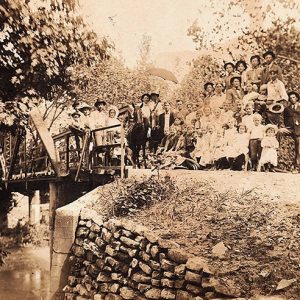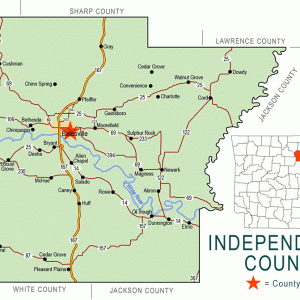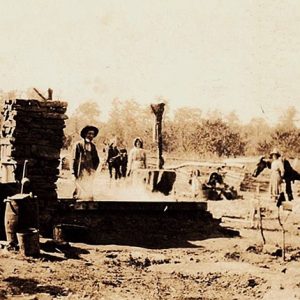calsfoundation@cals.org
Cedar Grove (Independence County) [Northeast]
There are two communities named Cedar Grove in Independence County, one south of the White River between Floral and Pleasant Plains, and the other north of the White River near Charlotte and Cave City (Sharp and Independence counties); the two communities are often confused. Both are historical communities dating back to before the Civil War. Both are said to take their names from clusters of cedar trees found in the areas where log homes were built by the first settlers. Each one has a Cedar Grove Cemetery.
Cedar Grove in the northeastern part of the county is located in Dota Township on Curia Creek seven miles southeast of Cave City and about fourteen miles east-northeast of Batesville (Independence County). It is located near the intersection of North Charlotte Road and Shamrock Lane. The Jackson Military Road, which was built in 1831 and paralleled the old Southwest Trail, was about three miles east of Cedar Grove and was a main highway in the 1800s. The alluvial Black and White river bottoms lie to the east and south.
Native Americans made the areas near the Black and White rivers their home in pre-Columbian times. At the beginning of the twentieth century, archaeologist Clarence Bloomfield Moore excavated several sites, including Little Turkey Hill, near what is today Dowdy (Independence County), about six and a half miles east-southeast of Cedar Grove.
The deed records at Powhatan (Lawrence County) show that French settlers claimed lands along the Black River following the Louisiana Purchase of 1803. These claims were settled in 1815, and the French settlers made deeds to a land speculator from St. Louis, Missouri, named William Russell.
The James family was among the first to settle in Cedar Grove, and many of their descendants continued to live in the community. Elisha K. James and two sons traveled to Arkansas Territory from Blount County, Tennessee, and are first shown in the territory on the 1830 census. After settling in Lee County and then serving as a justice of the peace in St. Francis County, Elisha K. James was, by 1844, living in Black River Township of Independence County. He died in 1850—reportedly while carrying home a gallon of rum on an icy night. One of his sons, William Elijah James, with his wife, Jane Ann Martha Goodwin James, and family built a home in Cedar Grove in 1855. A sign shows the site of the home place and reads, “Home place of Elijah and Jane James, original ancestors of the Cedar Grove James, 1855–1883.” The main burial grounds for Cedar Grove is the James Cemetery.
William Elijah James, who served in the Mexican War, enlisted together with his son Thomas in the Union army on July 20, 1862, as first lieutenant in Company C of the First Arkansas Volunteers, organized in Helena (Phillips County). The Cedar Grove area was a hotbed of Union activity throughout the war, making it a much divided community. James was captured in Helena and died of typhoid in an army hospital in Benton Barracks in St. Louis on November 14, 1862. His daughter, Caroline Virginia James Turner, drowned in the White River in December 1862, shortly after receiving word of her father’s death. Her husband was away serving in the Union army. Family members believe she was suspected of being a Union spy and murdered. Elijah’s son Thomas Jefferson James died on his way home from Missouri in 1863.
A founding member of Cedar Grove was Washington Monroe Lewallen, who in 1848 married Mary Ann Jane Wann in Jackson County, Alabama. By the 1850 census, the couple and their son were living on Reeds Creek (Lawrence County). Their daughter Martha Elizabeth Wann married William Elijah James II. Mary Ann Wann’s father, Robert Jasper Wann, had assisted in the Cherokee Removal in 1838 as part of Captain Joshua Wann’s Company under Norwood’s Battalion, Alabama Military, for three months. He mustered in with son Samuel Wann. The Trail of Tears had taken him near what would later be the home of Mary Ann and her husband in Cedar Grove.
Cedar Grove, with no post office of its own, was served by the Mobley (Sharp County) post office about a mile and a half to the north. The Mobley Post Office existed from 1891 until 1954. The general store at Cedar Grove was owned and operated by Dewey James and his father, George Washington (G. W.) James. The James Store was located on Cedar Grove Road on the Independence County side of the line with Sharp County.
The Bayou Dota Academy was established in the area in 1858. In 1936, the old wooden building used by the academy was demolished and replaced with a sandstone rock building built by the Works Progress Administration.
The children of Cedar Grove/Mobley attended the first school in the Etna community, four miles away from Cedar Grove, in the mid-1800s. After the Cedar Grove Missionary Baptist Church built a new building, school began on the hill of Cedar Grove in the 1870s. It is estimated that 150 children went to school there. Cedar Grove School District No. 95 was established in 1913 and merged with the Cave City and Charlotte schools in 1946. When it closed, every piece of the school was auctioned off.
Cedar Grove Missionary Baptist Church and Cemetery and its sister church, New Prospect Missionary Baptist Church, became Cedar Grove landmarks. The new Cedar Grove church was completed in 1945 to replace the original structure built during Reconstruction; the building still stands in the twenty-first century. The Prospect church building was moved to the Liles farm by Bill Liles and has been restored at Shamrock Lane in Charlotte.
The historic Cedar Grove Bridge across Curia Creek was built in 1912 and was a boost to the community and its economy. It was torn down in 1986 after an overloaded dump truck broke through, causing the bridge to be ruled unsafe by the county.
By the early 1900s, Cedar Grove was a bustling hamlet with a general store, two churches, a school, a wooden fire tower, and a sorghum mill, but changing times and the growth of nearby Cave City gradually drained the community of population. The main highways bypassed Cedar Grove. Beginning in 1926, Highway 25 became the main road between Cord (Independence County) and Strawberry (Lawrence County), with Highway 11 (changed to Highway 167 in 1962) as the main road between Batesville and Cave City. The demolition of the Cedar Grove bridge further isolated the community.
For additional information:
Arms, Orville. “A Brief History of the Cord-Charlotte School District.” Unpublished essay, 1998. On file at the Butler Center for Arkansas Studie,. Central Arkansas Library System, Little Rock, Arkansas.
Biographical and Historical Memoirs of Northeast Arkansas. Chicago: Goodspeed Publishing Co., 1889.
A History of Cave City, Arkansas. Mt. Vernon, IN: Windmill Publications, 2001.
McGinnis, A. C. “A History of Independence County, Ark.” Special issue. Independence County Chronicle 17 (April 1976).
Perkey, Gary, ed. A Newspaper History of Cave City, Arkansas: Excerpts from the Sharp County Record, Batesville Guard, Batesville Record, and Newark Journal Newspapers. Batesville, AR: Batesville Genealogical Society, 2003.
Powell, Wilson. “James Family, Cedar Grove Are Intertwined.” River Country, March 6–March 12, 1999, p. 3.
Weinstein, Richard A., David B. Kelley, and Joe W. Saunders, eds. The Louisiana and Arkansas Expeditions of Clarence Bloomfield Moore. Tuscaloosa: University of Alabama Press, 2003.
Kenneth Rorie
Van Buren, Arkansas
 Cedar Grove (Independence County) [Southwest]
Cedar Grove (Independence County) [Southwest] Cedar Grove Bridge
Cedar Grove Bridge  Independence County Map
Independence County Map  Sorghum Making
Sorghum Making 




Comments
No comments on this entry yet.